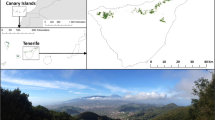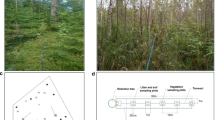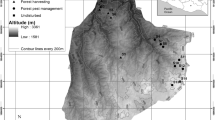Abstract
In the Mediterranean region, the spread and densification of woodlands and shrublands subsequent to rural depopulation is a critical issue for the conservation of open-habitat plant species. Our objective was to assess the effectiveness of forest management to reduce the negative impact of forest closure on the persistence of a protected herbaceous perennial species Paeonia officinalis. Using demographic surveys from 2003 to 2008 in a woodland, open and managed habitat clear-cutted for the aim of our study, we assessed the effect of forest opening on plant performance and population dynamics. In addition, we performed a shading experiment on reproductive plants to mimic canopy closure and study its impact on plant growth and fecundity. Based on quadrat surveys and matrix models, we showed that forest cutting induced a rapid increase in plant performance and population asymptotic growth rate. Indeed, within 2 years, plant size, flower, seed and ovule numbers as well as the plant stage distribution, asymptotic growth rates and elasticity patterns shifted from values similar to those in the woodland habitat to values similar to those in the open habitat. Similarly, artificially shaded reproductive plants regressed within 2 years towards the vegetative stage. For perennial plants which have a stage in their life-cycle which allows for individual survival under unfavourable conditions such as the vegetative stage for P. officinalis, such demographic plasticity may be fundamental for their long-term persistence in temporally heterogeneous environments. Our study highlights the need to mix an experimental approach with a mid-term demographic survey in order to design efficient conservation management strategies for declining populations of rare species.






Similar content being viewed by others
References
Agreste (2008) Chiffres et Données-Série Agriculture. L’utilisation du territoire en 2007: Teruti-Lucas. Ministère de l’agriculture, de l’agroalimentaire et de la forêt, Montreuil sous bois (in French)
André M (1998) Depopulation, land-use change and transformation in the French Massif Central. Ambio 27:351–353
Andrieu E, Debussche M (2007) Diaspore removal and potential dispersers of the rare and protected Paeonia officinalis L. (Paeoniaceae) in a changing landscape. Bot J Linn Soc 154:13–25
Andrieu E, Thompson JD, Debussche M (2007) The impact of forest spread on a marginal population of a protected peony (Paeonia officinalis L.): the importance of conserving the habitat mosaic. Biodivers Conserv 16:643–658
Barkham JP (1980a) Population-dynamics of the Wild Daffodil (Narcissus pseudonarcissus). 2. Changes in number of shoots and flowers, and the effect of bulb depth on growth and reproduction. J Ecol 68:635–664
Barkham JP (1980b) Population-dynamics of the Wild Daffodil (Narcissus pseudonarcissus). 1. Clonal growth, seed reproduction, mortality and the effects of density. J Ecol 68:607–633
Barkham JP (1992) The effect of coppicing and neglect on the performance of the perennial ground flora. In: Buckley GP (ed) Ecology and management of coppiced woodlands. University Press, Cambridge, pp 117–146
Batlla D, Kruk BC, Benech-Arnold RL (2000) Very early detection of canopy presence by seeds through perception of subtle modifications in red: far red signals. Funct Ecol 14:195–202
Brys R, Jacquemyn H, Endels P, De Blust G, Hermy M (2004) The effects of grassland management on plant performance and demography in the perennial herb Primula veris. J Appl Ecol 41:1080–1091
Brys R, Jacquemyn H, Endels P, De Blust G, Hermy M (2005) Effect of habitat deterioration on population dynamics and extinction risks in a previously common perennial. Conserv Biol 19:1633–1643
Bullock J, Hill B, Silvertown J (1994) Demography of Cirsium vulgare in a grazing experiment. J Ecol 82:101–111
Cadenasso M, Traynor M, Pickett S (1997) Functional location of forest edges: gradients of multiple physical factors. Can J For Res 27:774–782
Caswell H (2001) Matrix population models: construction, analysis, and interpretation. Sinauer Associates Inc, Sunderland
Cinotti B (1996) Evolution des surfaces boisées en France : proposition de reconstruction depuis le début du XIXe siècle. RFF 6:547–562 (in French with English abstract)
Cipollini ML, Wallacesenft DA, Whigham DF (1994) A model of patch dynamics, seed dispersal, and sex-ratio in the dioecious shrub Lindera benzoin (Lauraceae). J Ecol 82:621–633
Colas B, Kirchner F, Riba M, Olivieri I, Mignot A, Imbert E, Beltrame, Carbonell D, Fréville H (2008) Restoration demography: a ten-year demographic comparison between introduced and natural populations of endemic Centaurea corymbosa (Asteraceae). J Appl Ecol 45:1468-1476
Colling G, Matthies D (2006) Effects of habitat deterioration on population dynamics and extinction risk of an endangered, long-lived perennial herb (Scorzonera humilis). J Ecol 94:959–972
Daget P (1977) Mediterranean bioclimate-general characteristics and modes of definition. Vegetatio 34:1–20
Debussche M, Lepart J, Dervieux A (1999) Mediterranean landscape change: evidence from old postcards. Global Ecol Biogeogr 8:3–15
Delcros P (1994) Landscape ecology and post-cultural plant dynamics in mountain areas. Quae, Versailles
Ehrlen J, Syrjanen K, Leimu R, Garcia MB, Lehtila K (2005) Land use and population growth of Primula veris: an experimental demographic approach. J Appl Ecol 42:317–326
Endels P, Jacquemyn H, Brys R, Hermy M (2005) Rapid response to habitat restoration by the perennial Primula veris as revealed by demographic monitoring. Plant Ecol 176:143–156
Eriksson O (1996) Regional dynamics of plants: a review of evidence for remnant, source-sink and metapopulation. Oïkos 77:248–258
Garcia D, Zamora R, Hodar JA, Gomez JM (1999) Age structure of Juniperus communis L. In the Iberian peninsula: conservation of remnant populations in Mediterranean mountains. Biol Conserv 87:215–220
Jacquemyn H, Brys R, Honnay O, Hermy M (2008) Effects of coppicing on demographic structure, fruit and seed set in Orchis mascula. Basic Appl Ecol 9:392–400
Janeckova P, Wotavova K, Schodelbauerova I, Jersakova J, Kindlmann P (2006) Relative effects of management and environmental conditions on performance and survival of populations of a terrestrial orchid, Dactylorhiza majalis. Biol Conserv 129:40–49
Kirchner F, Robert A, Colas B (2006) Modelling the dynamics of introduced populations in the narrow-endemic Centaurea corymbosa: a demo-genetic integration. J Appl Ecol 43:1011–1021
Knox JS (1997) A nine year demographic study of Helenium virginicum (Asteraceae), a narrow endemic seasonal wetland plant. J Torrey Bot Soc 124:236–245
Kolb A, Leimu R, Ehrlen J (2007) Environmental context influences the outcome of a plant seed predator interaction. Oikos 116:864–872
Kreyer D, Oed A, Walther-Hellwig K, Frankl R (2004) Are forests potential landscape barriers for foraging bumblebees? Landscape scale experiments with Bombus terrestris agg. and Bombus pascuorum (Hymenoptera, Apidae). Biol Conserv 116:111–118
Lavergne S, Thompson JD, Garnier E, Debussche M (2004) The biology and ecology of endemic and widespread plants: a comparative study of trait variation in 20 congeneric pairs. Oikos 107:505–518
Lennartsson T, Oostermeijer JGB (2001) Demographic variation and population viability in Gentianella campestris: effects of grassland management and environmental stochasticity. J Ecol 89:451–463
Lepart J, Debussche M (1992) Human impact on landscape patterning: mediterranean examples. In: Hansen J, di Castri F (eds) Landscape boundaries, consequences for biotic diversity and ecological flows. Springer, New York, pp 76–106
Matlab (2009) The MathWorks Inc., Natick
Mazzoleni S, di Pasquale G, Mulligan M (2004) Reversing the consensus on mediterranean desertification. In: Mazzoleni S, di Pasquale G, Mulligan M, di Martino P, Rego F (eds) Recent dynamics of the mediterranean vegetation and landscape. Wiley, Chichester, pp 281–285
Médail F, Verlaque R (1997) Ecological characteristics and rarity of endemic plants from southeast France and Corsica: implications for biodiversity conservation. Biol Conserv 80:269–281
Menges ES (2008) Restoration demography and genetics of plants: when is a translocation successful? Aust J Bot 56:187–196
Menges ES, Dolan RW (1998) Demographic viability of populations of Silene regia in midwestern prairies: relationships with fire management, genetic variation, geographic location, population size and isolation. J Ecol 86:63–78
Menges ES, Ascencio PFQ, Weekley CW, Gaoue OG (2006) Population viability analysis and fire return intervals for an endemic Florida scrub mint. Biol Conserv 127:115–127
Ne’eman G (2003) To be or not to be—the effect of nature conservation management on flowering of Paeonia mascula (L.) Miller in Israel. Biol Conserv 109:103–109
Nicole F, Brzosko E, Till-Bottraud I (2005) Population viability analysis of Cypripedium calceolus in a protected area: longevity, stability and persistence. J Ecol 93:716–726
Oostermeijer J, Van’t Veer R, Den Nijs J (1994) Population structure of the rare, long-lived perennial Gentiana pneumonanthe in relation to vegetation and management in the Netherlands. J Appl Ecol 31:428–438
Oostermeijer J, Brugman M, De Boer E, Den Nijs J (1996) Temporal and spatial variation in the demography of Gentiana pneumonanthe, a rare perennial herb. J Ecol 83:153–166
Pavlik BM (1996) Defining and measuring success. In: Falk DA, Millar CI, Olwell M (eds) Restoring diversity. Strategies for reintroduction of endangered plants. Island Press, Washington, pp 127–156
Petit C, Thompson J (1998) Phenotypic selection and population differentiation in relation to habitat heterogeneity in Arrhenatherum elatius (Poaceae). J Ecol 86:829–840
R Development Core Team (2005) R: A language and environment for statistical computing, reference index version 2.7.1. R Foundation for Statistical Computing, Vienna. http://www.R-project.org
Schleuning M, Matthies D (2009) Habitat change and plant demography: assessing the extinction risk of a formerly common grassland perennial. Conserv Biol 23:174–183
Shefferson R, Kul LT, Tali K (2006) Demographic response to shading and defoliation in two woodland orchids. Folia Geobot 41:95–106
Silvertown J, Franco M, Pisanty I, Mendoza A (1993) Comparative plant demography-relative importance of life-cycle components to the finite rate of increase in woody and herbaceous perennials. J Ecol 81:465–476
Silvertown J, Franco M, Menges ES (1996) Interpretation of elasticity matrices as an aid to the management of plant populations for conservation. Conserv Biol 10:591–597
Stott I, Townley S, Hodgson DJ (2011) A framework for studying transient dynamics of population projection matrix models. Ecol Lett 14:959–970
Thompson JD (2005) Plant evolution in the Mediterranean. Oxford University Press, Oxford
Ticktin T, Nantel P (2004) Dynamics of harvested populations of the tropical understory herb Aechmea magdalenae in old-growth versus secondary forests. Biol Conserv 120:461–470
Tutin T, Burges N, Chater A, Edmondson J, Heywood V, Moore D, Valentine D, Walters S, Webb D (1993) Flora Europaea. Cambridge University Press, Cambridge
Valladares F, Dobarro I, Sanchez-Gomez D, Pearcy R (2005a) Photoinhibition and drought in Mediterranean woody saplings: scaling effects and interactions in sun and shade phenotypes. J Exp Bot 56:483–494
Valladares F, Arrieta S, Aranda I, Lorenzo D, Sanchez-Gomez D, Tena D, Suarez F, Pardos J (2005b) Shade tolerance, photoinhibition sensitivity and phenotypic plasticity of Ilex aquifolium in continental Mediterranean sites. Tree Physiol 25:1041–1052
Valverde T, Silvertown J (1995) Spatial variation in the seed ecology of a woodland herb (Primula vulgaris) in relation to light environment. Funct Ecol 9:942–950
Valverde T, Silvertown J (1998) Variation in the demography of a woodland understorey herb (Primula vulgaris) along the forest regeneration cycle: projection matrix analysis. J Ecol 86:545–562
Van Calster H, Endels P, Antonio K, Verheyen K, Hermy M (2008) Coppice management effects on experimentally established populations of three herbaceous layer woodland species. Biol Conserv 141:2641–2652
Warren M, Thomas J (1992) Butterfly responses to coppicing. In: Buckley GP (ed) Ecology and management of coppiced woodlands. Chapman and Hall, Cambridge, pp 249–270
Whale DM (1984) Habitat requirements in Primula species. New Phytol 97:665–679
Wilhere G (2002) Adaptive management in habitat conservation plans. Conserv Biol 16:20–29
Williams JL, Ellis M, Bricker MC, Brodie JF, Parsons EW (2011) Distance to stable stage distribution in plant populations and implications for near-term population projections. J Ecol 99:1171–1178
Acknowledgments
This work was funded by the European programme “Mediterranean Mountain Ecosystems in a Changing World”, the C.N.R.S. Long-Term Research Area “Mediterranean Backcountry”, grant ANR-05-BDIV-014 (ABIME) from the Agence Nationale de la Recherche, and Ph.D grants from the French government to Emilie Andrieu and Valentine Vaudey. We are grateful to the Office National des Forêts for access to land as well as for funding and conducting the clear-cutting experiment. We thank Annabelle Dos Santos for their help in the field. All experiments in this study complied with the current French law concerning protected species.
Author information
Authors and Affiliations
Corresponding author
Electronic supplementary material
Below is the link to the electronic supplementary material.
Rights and permissions
About this article
Cite this article
Andrieu, E., Fréville, H., Besnard, A. et al. Forest-cutting rapidly improves the demographic status of Paeonia officinalis, a species threatened by forest closure. Popul Ecol 55, 147–158 (2013). https://doi.org/10.1007/s10144-012-0346-1
Received:
Accepted:
Published:
Issue Date:
DOI: https://doi.org/10.1007/s10144-012-0346-1




